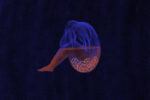Science fiction is often associated with fantastical concepts, such as the Force from “Star Wars” or the numerous alien worlds of “Star Trek.” While these and many other examples of the genre present hypothetical inventions, few works offer these ideas as their central focus.
The science fiction novels of Jules Verne stand apart in this respect, as they use scientific research and calculations to showcase fictional machines that would become real creations many years later. Verne’s detailed descriptions of his ideas weren’t always accurate, but his work paved the way for many modern innovations.
Underwater Exploration in “Twenty Thousand Leagues Under the Sea”
Over 150 years after its release, “Twenty Thousand Leagues Under the Sea” from 1870 remains one of Verne’s most recognized and critically acclaimed works. The book chronicles the journey of Dr. Pierre Aronnax, a marine biologist who embarks on a hunting expedition with his servant, Conseil, and a harpooner named Ned Land. This expedition is cut short when they discover that the rumored sea monster they were searching for was actually a technologically advanced submarine called the Nautilus.
The three accompany its elusive Captain Nemo and his crew on their undersea travels. They learn about undocumented species of plants and sea creatures, explore underwater locations, and uncover the reason behind Nemo’s secretive nature and refusal to let the group return to land. The constant sense of mystery and wonder that Verne creates in “Twenty Thousand Leagues Under the Sea” is one that few other authors have successfully recreated.
Aside from the novel’s excellent storytelling and characters, “Twenty Thousand Leagues Under the Sea” is notable for its immense detail in describing an electronically powered submarine years before the concept was fully realized. Verne describes the Nautilus as cigar-shaped with a surface area of 1,011.45 square meters, a volume of 1,507.2 cubic meters, a length of 70 meters and a weight of 1,500 metric tons when completely submerged in water.
The novel also details how these measurements could impact the Nautilus’ movement in various circumstances. Even though the Nautilus seemed like an impossible idea when the book was written, Verne’s precise descriptions help the reader believe the fictional submarine could be a real machine.
The Nautilus is a culmination of Verne’s personal research into earlier submarine prototypes and calculations on how they could be improved. Verne studied some of the most notable designs, including the Nautilus’s namesake and the Plongeur. A model of the latter submarine at the International Exposition of 1867 served as one of the primary inspirations for “Twenty Thousand Leagues Under the Sea.” These inspirations allowed Verne to create a realistic vision of future submarine designs.
However, his limited knowledge of the subject and occasional use of creative liberties meant the fictional submarine’s design suffered from multiple scientific inaccuracies. An essay by Stuart K. Wier found the Nautilus to be surprisingly close to the designs of later submarines but argued its power source of sodium batteries (another prophetic invention by Verne) lacked the necessary power and longevity to support the submarine’s large size and maximum speed of 50 miles per hour. He proposes that the Nautilus could have only been powered by a nuclear reactor, another invention that had yet to be conceived while Verne was writing.
Despite its occasional inaccuracies, “Twenty Thousand Leagues Under the Sea” contained enough scientific elements to inspire the creation of Simon Lake’s Argonaut 1, the first submarine to travel in the open sea successfully. Once news about this accomplishment spread around the world, Verne sent a telegram to Lake discussing the impact the invention would have on underwater exploration and warfare.
Verne may not have intended for his novel to drastically impact the future of science. Still, his unusual dedication to mechanical accuracy in literature helped him become a household name among casual readers and scientists alike.
Interstellar Travel in “From the Earth to the Moon”
Although Verne was able to consult earlier prototypes when designing the Nautilus, the concept of traveling into space had seen significantly less progress. Despite the lack of professional research available at the time, Verne’s 1865 “From the Earth to the Moon” delivered an early concept of a device that could send humans to the moon. The story presents the fictional Baltimore Gun Club and their efforts to construct a 900-foot cannon named the “Columbiad,” which would launch a projectile containing human passengers toward the moon.
Verne describes the Columbiad with a similar degree of detail as the Nautilus, including information on how he reached many of his mathematical conclusions within the novel. He explains the construction of the cannon and the measurements performed to determine its design. Unlike the Nautilus, his imagined cannon hardly resembles any modern technology and contains numerous impractical design elements.
In an article for Gizmodo, Ron Miller explains that Verne depicts a cannon rather than a rocket because of the differences in technical advancement between the two devices. Rockets were far less powerful than necessary to launch into space, whereas the cannon was already known as a powerful invention.
The choice may seem odd now, but readers at the time (and possibly Verne himself) were more likely to believe space travel could be accomplished with a cannon rather than the comparatively weak contemporary rockets.
Despite Verne’s attempts at scientific accuracy, the Columbiad suffers from numerous design flaws. The power and speed required to launch the projectile would subject its occupants to a fatal force of 30,000 Gs (or g-force, the force of gravity or acceleration on a body). The cannon would also compress and heat the air within its barrel, creating a dangerous obstacle for the projectile during its launch. It would be a guaranteed failure if Verne’s cannon were ever attempted in real life.
Even with these problems, “From the Earth to the Moon” successfully predicted and directly inspired the projects of future space programs. The Columbiad served as the basis for multiple military projects that attempted to create a “space gun.” However, as Verne described, none of these projects successfully launched a projectile to the moon.
Additionally, Verne’s novel portrays a conflict between Florida and Texas as they attempt to convince the Gun Club to construct the cannon on their land. After an extensive debate, the club determined Tampa, Florida (named “Tampa Town” in the novel), to be the ideal location for the cannon due to its distance from other towns and closeness to the equator; the latter created a direct path to the moon.
These events would be repeated nearly a century later, in 1962, when NASA rejected a location near Brownsville, Texas, in favor of Merritt Island, Florida, for the construction of the Kennedy Space Center. An interview with Robert Launius, a historian and curator at the Smithsonian National Air and Space Museum, revealed that this choice was also inspired by its closeness to the equator and distance from civilian areas.
The book “From the Earth to the Moon” is far from being a scientifically accurate novel, but it embodies everything that made Verne’s works so notable. His combination of extensive research and entertaining, grounded fiction introduced the study of space travel to many readers and encouraged future scientists to question how to bring the novel’s ideas to life. Most importantly, the book provides contemporary readers with an understanding of how the field of astronautics was perceived in the middle of the 19th century.
Everyday Devices of “Paris in the Twentieth Century”
Verne’s most popular novels often adopt a pro-science perspective toward new inventions. The Nautilus, Columbiad and other inventions by Verne are depicted as beneficial to the advancement of science. However, his later works contrast with this approach by adopting a more cynical tone, with many of these novels delivering cautionary tales against the possible dangers of technology.
One of the most notable examples is an unpublished 1863 manuscript titled “Paris in the Twentieth Century.” The story attempts to imagine the city of Paris and its people from 100 years into the future. This concept is explored through the lens of Michel Dufrénoy, a teenage literature major who grows increasingly resentful of the technology-focused world as the novel progresses. Verne’s view of the 20th century is primarily dominated by tech companies, whereas aspiring artists and writers are typically destitute.
Verne’s publisher, Pierre-Jules Hetzel, rejected the draft and harshly criticized the story as being overly pessimistic and unrealistic. However, the novel has since been reevaluated as a surprisingly accurate vision of the future after it was rediscovered by Verne’s great-grandson, Jean Verne, and finally published in 1994.
Along with a surprisingly accurate description of the future prioritization of technology, “Paris in the Twentieth Century” described multiple inventions that arose during or near the 1960s.
Verne envisioned drastic innovations in transportation in the form of increased roads for automobiles and the creation of a subway network. He also predicted computers and the internet when describing “calculating machines” that operated through keyboards and served as “electric telegraphy” for global communication.
One final prediction, and perhaps the most optimistic part of the novel, was the concept of weapons of mass destruction that would deter countries from engaging in war. These are not the only examples of Verne’s foresight, but they highlight his understanding of how technology would restructure modern life.
Conclusion
Verne was not an expert in any scientific or engineering fields. He lacked formal training in many of the subjects described in his novels and primarily wrote adventure novels set in different parts of the world rather than science fiction.
Despite his lack of expertise, his dedication to creating believable yet imaginative stories used the science-fiction genre to its fullest potential. As a result, his works can be enjoyed as entertaining adventure novels and as historical treatises on what the future of science would look like from a 19th-century perspective.

















